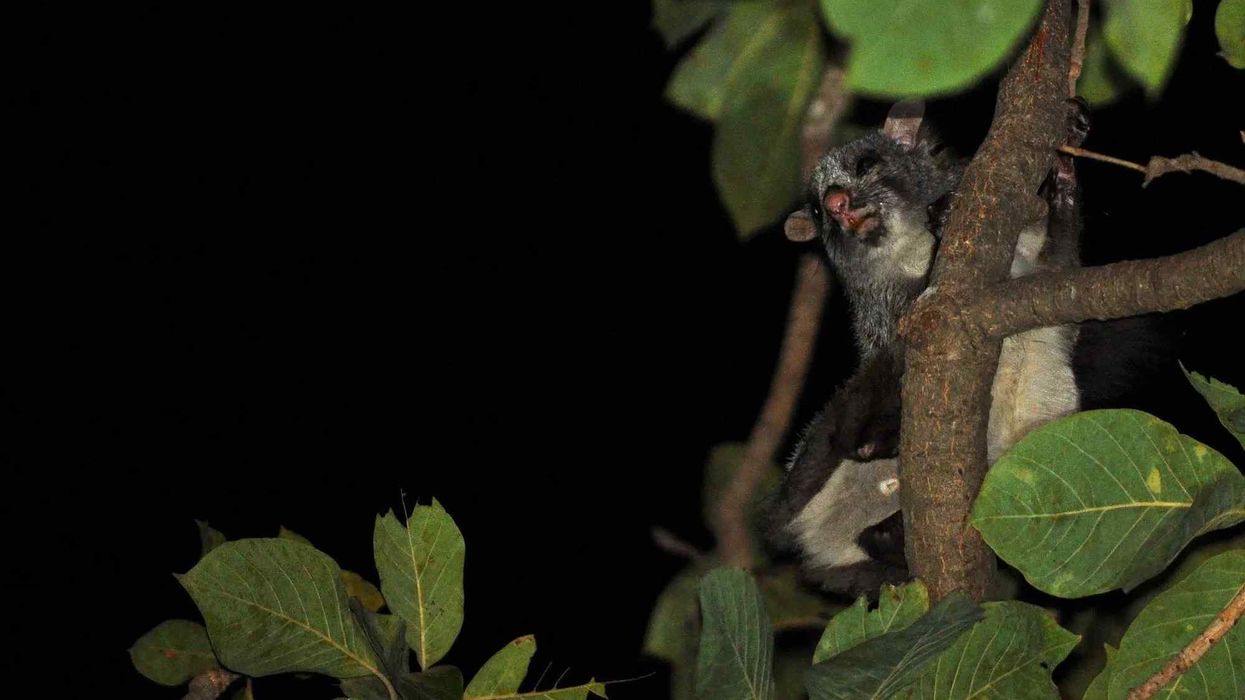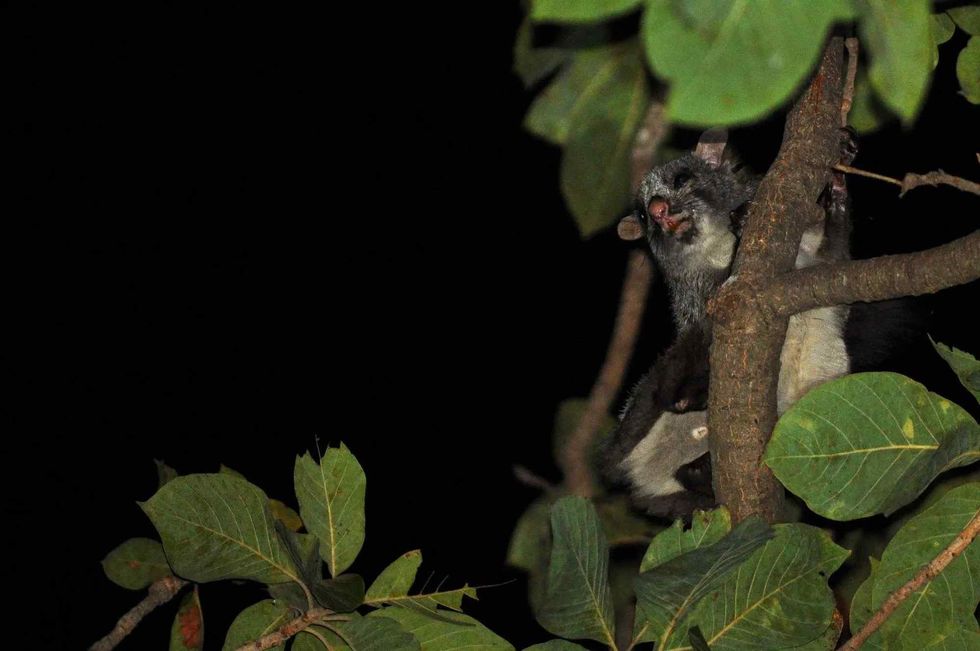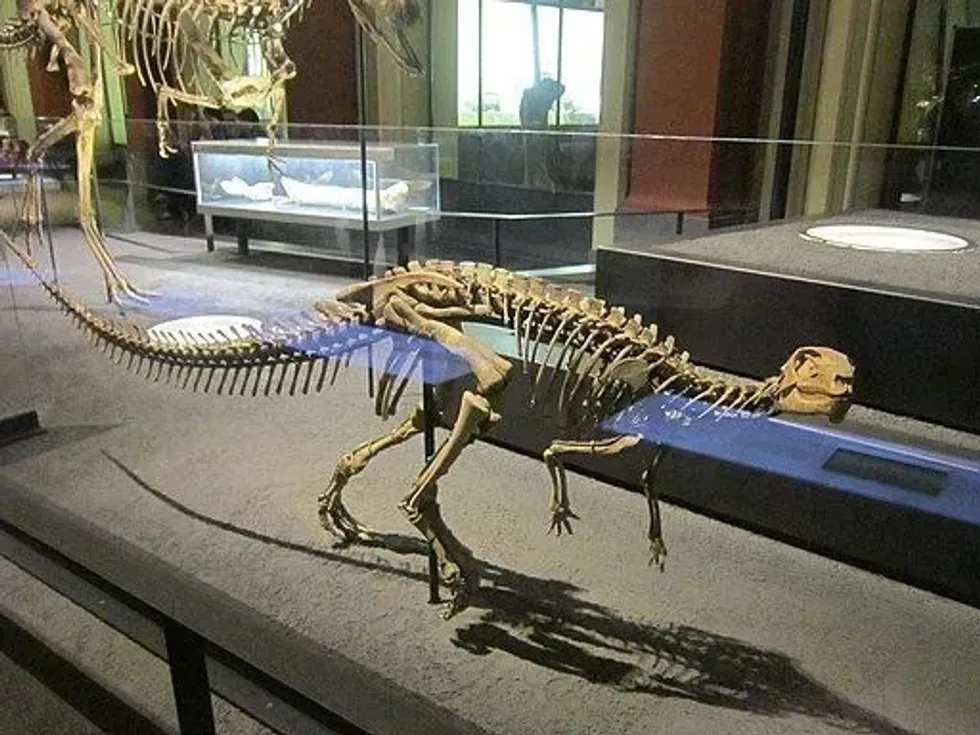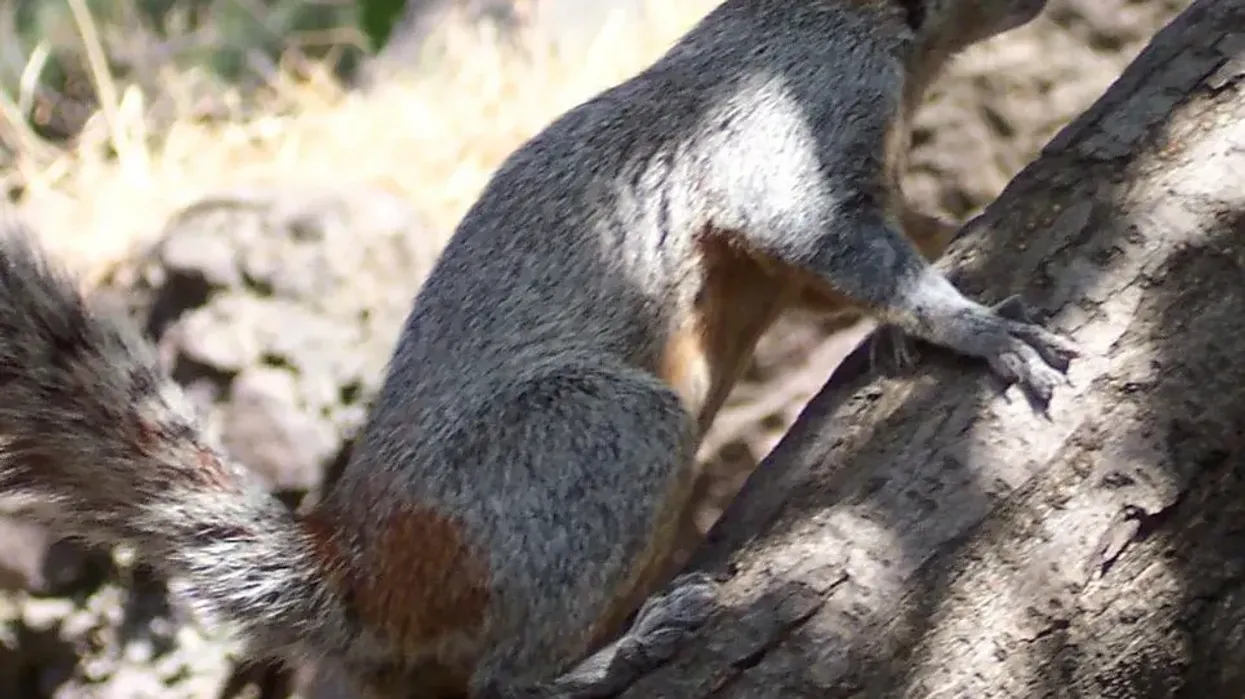The giant flying squirrel species is a common sight in South Asia, typically found in India, China, Sri Lanka, the Himalayan mountains, and other countries in Southeast Asia. They are also a frequent occurrence in the Malay Peninsula and Taiwan.
Their scientific name is Petaurista philippensis, a closely related species of the northern flying squirrel.
A native of Asia, the squirrels are nocturnal in nature and live in between trees, preferably in evergreen or deciduous forest habitats.
Appearance-wise, the Indian giant flying squirrels have a longer landing platform, range, and usually glide around in the dense forest habitat of Asia with their almost black to the dark maroon body, with white tips sometimes giving off a gray, light brown, to white color.
They are sexually dimorphic so the male and female look quite similar.
The breeding interval usually occurs in two phases where the female gives birth to only one or two squirrel pups. Their diet includes insects, plants, and fruits as they are omnivorous in nature while they leap around trees in search of food.
If you liked reading about flying squirrels then we suggest you check out Japanese giant flying squirrel facts and giant flying squirrel facts as well!
Indian Giant Flying Squirrel Interesting Facts
What type of animal is an Indian giant flying squirrel?
The Indian giant flying squirrel is a type of rodent from the animal kingdom.
What class of animal does an Indian giant flying squirrel belong to?
The Indian giant flying squirrel belongs to the Mammalia class of animals from the family of Sciuridae.
How many Indian giant flying squirrels are there in the world?
The Indian giant flying squirrels are present in abundance in their preferred habitats of South Asia and Southeast Asia. It might be declining in its population size due to hunting and poaching but its exact population count still remains unknown.
Where does an Indian giant flying squirrel live?
The wide range of distribution of the Indian giant flying squirrel is mostly around South Asia, central China, and Southeast Asia where it is found in Sri Lanka, India, Bangladesh, China, Taiwan, and the Malay Peninsula at elevations of 328.08-8202.09 ft (100-2500 m).
What is an Indian giant flying squirrel's habitat?
Being a nocturnal species, Indian giant flying squirrels (Petaurista philippensis) prefer living in evergreen and deciduous forests as well as in plantations where they occupy holes and tree canopies. They also stay in coniferous and hardwood forests, but the distribution is relatively low compared to their tropical abundance.
Who do Indian giant flying squirrels live with?
The species of flying squirrels are not quite very sociable and prefer living alone. They usually leave their nests in the evening and return only before dawn. Their activities tend to increase during nighttime but may vary depending on the month. So they are usually seen alone or in pairs, only during the breeding season.
How long does an Indian giant flying squirrel live?
The Indian giant flying squirrel's average life expectancy is estimated to be about 6-15 years.
How do they reproduce?
Very little information about this squirrel's mating system is known due to its location and behavioral pattern but what we do know is that they are polygynous in nature. The male changes their diet and activities to attract mates during the two breeding seasons, one from February-March and the second from July-August, which lasts for two weeks.
A female may mate with an average of three to five males but reproduce only one offspring.
The female gives birth to at least two pups and the gestation occurs for 46 days after which, the squirrels are raised by their mothers and remain in her care for three months. The pups are independent after 95-185 days.
What is their conservation status?
Indian giant flying squirrels fall under the Least Concern category of animals according to the IUCN.
Indian Giant Flying Squirrel Fun Facts
What do Indian giant flying squirrels look like?

The flying squirrels (Petaurista philippensis) are similar to the northern flying squirrel in appearance. They are a large-sized mammal, also comparatively similar to the Red giant flying squirrel from the East Asian continent.
The squirrels can grow to a maximum length of 16.92 in (43 cm). The Squirrel's lower body parts are gray, with large, round eyes, and a soft coat.
Their flying membranes extend from their wrist to the ankles which helps them to glide from one tree to another. They have a mixed color of dark maroon, black, white, and gray on the sides.
How cute are they?
There is no doubt that flying squirrels are one of the cutest animals on Earth with their big round eyes, soft coat of fur, and long bushy tail. Not to forget that they look adorable when they spread their wings and glide from one tree to another in their safe and comfortable forest habitats.
How do they communicate?
There is very little information regarding the tree squirrels' species communication and behavioral patterns, but they are known to possess highly developed vision and other sensory abilities that help them to navigate at night due to their nocturnal nature. They also communicate through chemical and auditory cues during breeding seasons in the dark night hours.
How big is an Indian giant flying squirrel?
The flying squirrel's species can grow up to a body length of 16.92 in (43 cm). Other species like the giant flying squirrel can grow to a much bigger size.
How fast can an Indian giant flying squirrel move?
Flying squirrels can glide up to a length of 300 ft (91.44 m) and make complete 180 degree turns smoothly in midair by jumping off from trees, but they do not have complete flying capabilities like bats. They can easily jump around from one tree to another tree with ease.
How much does an Indian giant flying squirrel weigh?
They have an average weight of 2.20-5.51 lb (1-2.5 kg) but can sometimes be larger than a house cat. The American species are relatively tiny but the Asian flying squirrels are quite big.
What are the male and female names of the species?
All breeds of male squirrels are called boars, while the females are usually called sows. Other than that, they do not have any specific names and can be referred to by their common names or scientific names.
What would you call a baby Indian giant flying squirrel?
Baby flying squirrels can be referred to as kittens or pups and are born blind.
What do they eat?
This night-loving squirrel is omnivorous in nature whose diet typically consists of insects, larvae, lichens, flowers, plants, bark, leaves, fruits, and nuts found in their range of forest and plantations habitat.
Are they dangerous?
No, as far as reports go flying squirrels (P. philippensis) are harmless and do not pose any health hazard. The species is not aggressive, even if they have sharp teeth. The maximum damage they can inflict is a scratch or bite while defending themselves, but nothing more than that.
Would they make a good pet?
Yes, considering the species' non-aggressive nature, easy food habits, and cute features, they can make a good companion as a pet, but keeping one is not recommended as these are wild mammals who are meant to stay outdoors, gliding around every other tree as much as they want because they belong to the wild.
Did you know...
Their adorable big round eyes are actually very important to them as these eyes are the reason why they can easily move around at night.
They help them to collect more light for their nocturnal behavior to adapt to the night and its darkness working quite similarly to how a ring-tailed lemur's eyes work. Not to forget that these species can also glow at night.
Researchers have said that they produce a pink glow when shined under ultraviolet light and the color is more prominent on their undersides but the reason for it still remains a mystery.
The Indian giant flying squirrel's flight
Flying squirrels technically do not fly but are gliding from one tree to another.
They are not capable of true flight like bats or birds but possess a special kind of stretchy membrane from their wrists to their ankles which helps them in the act of gliding in the air.
Flying squirrels launch themselves from the edge of a high branch of trees while spreading out their limbs so that the stretching membrane is exposed and use a slight movement of their leg to steer the way to the destination.
The squirrel's tail is used as a break when it reaches its desired location and helps them to stop its movement.
Since their flight is dependent on trees, treetops, and canopies, they are usually found in evergreen forests and woodlands where they take shelter in holes and abandoned nests of other birds and squirrels.
What eats giant flying squirrels?
Although Indian giant flying squirrels are known to be great escapists due to their special membrane that allows them to glide away from their problems, there are still a couple of predators who are able to catch and consume them. These predators include owls, hawks, raccoons, cats, weasels, martens, bobcats, lynx, golden tree snakes, and coyotes.
The decline in the population of the flying squirrels is not only related to their predators but a definite loss of habitat due to human interferences and natural disasters. This is just one of the reasons why we should save forests so that we can see these beautiful creatures having a good time.
Now, what you can do is avoid unnecessary cutting of trees and help preserve them with reliable conservation groups and work towards the safety of nature and its resources.
Here at Kidadl, we have carefully created lots of interesting family-friendly animal facts for everyone to discover! For more relatable content, check out these naked mole rat facts and tufted titmouse facts for kids.
You can even occupy yourself at home by coloring in one of our free printable Indian giant flying squirrel coloring pages.
Second image by Pratik Jain.









